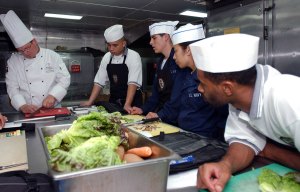
16 Sep Food Handling
Food Handling
 Food handling in restaurants, catering firms, food service vendors, fast food chains and grocery store kitchens involves a variety of cooking and preparation techniques. Chefs, cooks, and food service workers need to be aware of hazards in the kitchen to serve safety with their cuisine.
Food handling in restaurants, catering firms, food service vendors, fast food chains and grocery store kitchens involves a variety of cooking and preparation techniques. Chefs, cooks, and food service workers need to be aware of hazards in the kitchen to serve safety with their cuisine.
Kitchens can be busy, hectic places, so watch workers and the workflow to prevent slips, trips and falls. Have designated entry and exit doors. Walk in the kitchen area; don’t run. Place mirrors in areas that may have blind corners. Warn other workers when you are behind them or “coming through.” Service may need to be quick, but pace yourself to be safe.
Good housekeeping prevents accidents. Keep the floors clean and clear of clutter. Mop up spills immediately and use caution signs while they dry. Use drip mats and/or slip-resistant surface coatings to give traction in areas that build up moisture. Wear comfortable, supportive shoes with a closed toe and a slip-resistant sole.
Avoid cuts and punctures by handling knives properly. Use sharp knives that are the correct size and type for the job task. Avoid discussions and distractions while you are cutting. Keep your fingers and thumb away from the cutting zone. Always cut away from your body. Use a cutting board; don’t cut or filet in your hand. Keep knives in a storage area with the blades facing a single direction. Place dirty knives in a separate container for washing.
Kitchen equipment like slicers, mixers, and blenders can catch your hair, fingers or clothing in the moving parts. Tie your hair back and remove or secure your jewelry. Wear long, fitted sleeves. Make sure that safety guards are in place before you operate kitchen equipment. Wait for equipment to stop moving completely before you remove guards or access the prepared food.
Fryers, boilers, steamers, ovens, grills, heat lamps along with boiling water and liquids can cause severe burns if you are careless around them. Know how to maintain and use hot cooking appliances properly. Use tools, not your fingers, on cooked food. Use hot pads, mitts or aprons to protect yourself from hot surfaces, pans, plates, and appliances. Don’t use wet towels to hold hot handles or plates; the heat will transfer and steam your fingers. Control heat sources so liquids don’t boil over. Keep water sources away from hot oils and fryers. Stand back when you lift pot and steamer lids.
Food handling requires standing still during chopping, slicing, dicing, and food assembly. Use anti-fatigue mats at prep stations that require you to stand for long periods. You will often need to lift and move heavy supplies, pots, and kettles. Use a mechanical lift device or ask for assistance whenever possible. When you must lift, keep loads close to your body and avoid twisting while you carry and place items. Rotate your job tasks throughout the day and take micro breaks every 20-30 minutes to avoid fatigue.
Be prepared for emergencies in the kitchen. Know how to use the fire extinguishers and grill or hood extinguishers in the food preparation area. Keep extinguishers charged and accessible. Learn about other fire prevention and suppression techniques. Keep up to date on your first aid for burns and cuts, CPR technique, and treatment for choking

